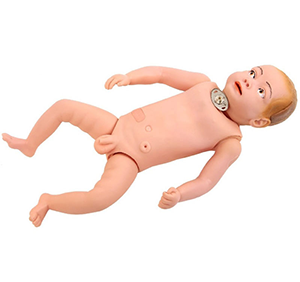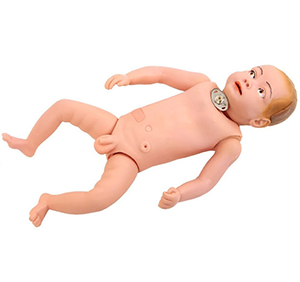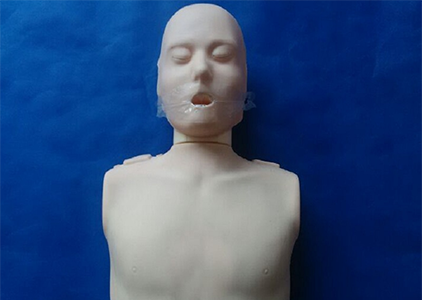
Infant tracheotomy is a high-risk emergency technique, especially in newborns and infants, due to its narrow, fragile airway, difficulty of operation and higher complication rate. In such cases, paramedics need to have a high level of expertise and the ability to respond quickly to emergencies. Traditional training methods often fail to fully simulate complex clinical situations, leading to nursing staff prone to operational errors or delayed treatment in emergency situations. The advanced infant tracheotomy nursing model, as a highly simulated training tool, can effectively simulate emergency situations, thereby improving the emergency response and technical execution of the nursing staff in the real environment.

Advanced Infant Tracheotomy Nursing Model
1. Simulate emergency respiratory distress situation
Infant tracheotomy is often used in emergencies such as severe respiratory distress or airway obstruction, especially when other respiratory support methods, such as intubation, cannot maintain an open airway. The advanced care model simulates a variety of emergency respiratory distress situations so that the nursing staff can conduct repeated training in a risk-free environment. For example:
Airway obstruction simulation: The model simulates complete or partial obstruction of the airway, challenging caregivers to quickly identify and resolve the problem to ensure effective airway obstruction.
Blood oxygen saturation decline: The model is equipped with sensors that simulate changes in blood oxygen saturation in real time, helping caregivers learn how to adjust respiratory management based on oxygen saturation data.
- Simulation of complications: The occurrence of complications such as airway damage and bleeding requires the nursing staff to quickly identify symptoms and take correct measures.
This highly reductive simulation of emergency situations helps to develop the clinical thinking and operational responsiveness of caregivers.
2. Real-time data feedback to improve emergency response capability
Advanced infant tracheotomy care models are typically equipped with sensors and data feedback systems that monitor the details of care operations in real time and provide feedback. These features include:
- Depth and Angle of intubation: The model provides immediate feedback based on the Angle and depth of the intubation to help the caregiver ensure the accuracy of the tracheotomy.
Breathing sounds and oxygen saturation: The model can simulate the baby's breathing sounds after tracheotomy, and the changing sounds can indicate whether the caregiver has successfully opened the airway. Changes in oxygen saturation can help caregivers determine airway patency and the presence of other complications.
- Heart rate and blood pressure monitoring: The model provides real-time data on heart rate and blood pressure, and caregivers need to make adjustments based on these physiological data.
The research shows that training with these high simulation models with data feedback can significantly improve the operational accuracy and emergency response speed of caregivers, especially the ability to make the right decision at the critical moment.
3. Case study: Effect of training on emergency airway management
One study compared the training of two groups of caregivers: one group was simulated using an advanced infant tracheotomy care model, and the other group was trained through a traditional classroom presentation and simulated human. The results showed that paramedics trained with the model had a 30 percent better success rate when dealing with emergencies and about a 20 percent reduction in operating time. Especially in the simulated emergency situation, nurses in the model training group were able to complete tracheotomy operation and successfully maintain airway patency in a short time, which greatly improved their emergency response ability in the real clinical environment.
In addition, data analysis also showed that after model training, nursing staff's ability to predict complications and coping strategies were significantly improved, and the error rate was significantly reduced. This shows that the high simulation model can not only simulate emergency situations, but also help caregivers better cope with stress and high-risk operations, and improve clinical handling capacity.
4. Conclusion: Improve emergency care skills to ensure patient safety
The Advanced infant tracheotomy nursing model provides a realistic training platform for caregivers to effectively simulate emergency situations in infant tracheotomy, thereby improving their operational skills and emergency response ability. With accurate operational simulation, real-time feedback, and a highly simulated environment, caregivers can practice repeatedly in a risk-free environment and be fully prepared for real-world clinical operations. With the wide application of this model, not only can improve the quality of care, but also effectively reduce the risk of patients caused by improper operation, and ultimately ensure that every baby who receives tracheotomy treatment can receive safe and accurate care.







Sophie Asveld
February 14, 2019
Email is a crucial channel in any marketing mix, and never has this been truer than for today’s entrepreneur. Curious what to say.
Sophie Asveld
February 14, 2019
Email is a crucial channel in any marketing mix, and never has this been truer than for today’s entrepreneur. Curious what to say.